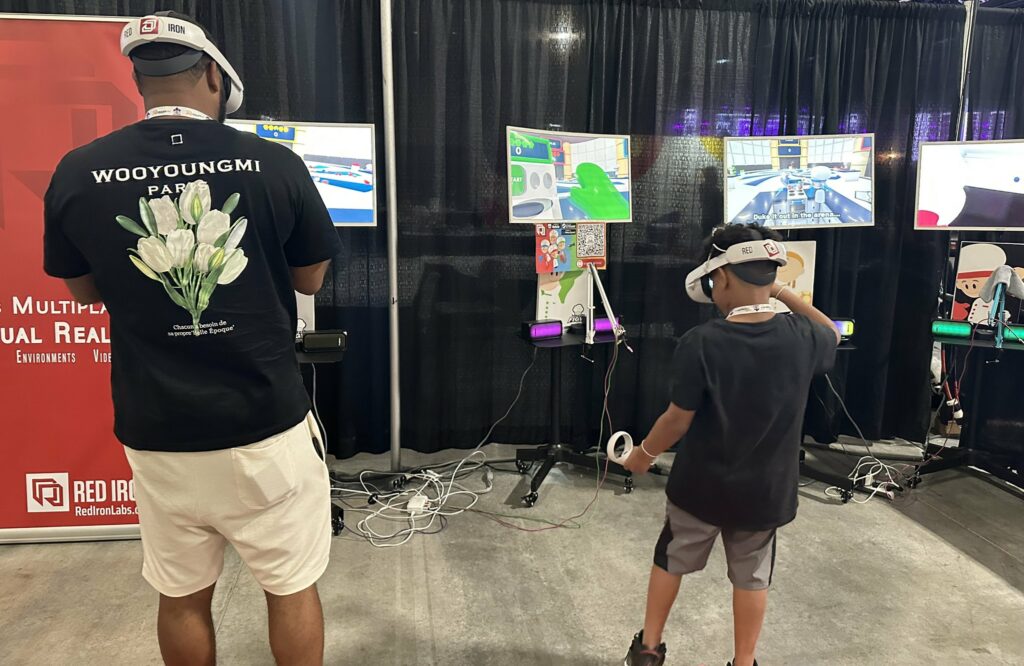Social multiplayer for VR gaming isn’t just a feature; it’s how today’s gamers connect. From Muffin Fight to MRDRBRS, we’ve seen firsthand how multiplayer design brings players together and even pulls spectators into the fun. Here’s what we’ve learned about creating engaging social experiences in VR, with insights on spectator appeal and accessibility that make games memorable.

Picture this: a crowd of kids at a game event, eyes glued to the screen as they dive into a game that’s all about speed, skill, and just a little chaos. Since early-2022, we’ve brought Muffin Fight to over 30 days of events, from conventions to pop-up gaming booths. The young crowd, typically around 10–12 years old, couldn’t get enough of its competitive, wholesome energy. They’d jump in, often with their parents watching and laughing along as the kids yelled and celebrated each victory.
But over time, we noticed something interesting: while Muffin Fight had multiplayer and social features, the experience felt a bit limited, especially at its original price point. This feedback helped us rethink aspects of MRDRBRS, where we want to create a game with dynamic multiplayer experiences that hold people’s attention over and over again, while also making it accessible to a broader audience. Our goal with MRDRBRS is to redefine social multiplayer for VR gaming, making it accessible and enjoyable for players and spectators alike.

Why Social Multiplayer for VR Gaming is Essential for Gen Z/Alpha Gamers
For today’s teens, games are social spaces, which is where they hang out, chat, and challenge each other. In 2014, the Entertainment Software Association reported that 77% of teens played multiplayer games to connect with friends. A decade later, this trend persists. A 2024 Pew Research Center study found that 72% of teen gamers play to spend time with others, and 47% have made friends online through gaming. These findings highlight the enduring role of multiplayer gaming in fostering social connections among teens.
This trend of social gaming aligns with what we saw at our Muffin Fight events, where kids thrived in the multiplayer chaos, bonding over competition and shared gameplay moments. In developing MRDRBRS, we’re taking these dynamics to heart, creating multiplayer features that aren’t just about playing— they’re about connecting.
How MRDRBRS Builds Social Multiplayer for VR Gaming
From our Muffin Fight experience, we know that kids love competition and love the thrill of playing together, even in a virtual space. With MRDRBRS, we aim to bring that same energy to VR, but with more depth. Our multiplayer mode offers ways for players to connect with friends or join strangers. Like Muffin Fight, MRDRBRS is fast-paced and easy to play. Simple gestures and intuitive controls make jumping in easy for everyone.
We’ve also taken lessons from those event setups, where parents and friends acted as spectators, laughing along with the chaos. MRDRBRS is designed with spectator engagement in mind, so even those watching the game—from parents to friends online—can feel part of the experience. This feature reflects the broader trend in gaming culture where content creators and streamers invite their followers into the game, letting them feel like they’re part of the action.
Creating an Inclusive Experience Across VR and Non-VR
Not everyone has VR hardware, which can limit the ability to enjoy these experiences. So, we’re ensuring MRDRBRS works for both VR and non-VR players. This decision is driven by what we learned from Muffin Fight—we want people to feel welcome, whether they have the latest tech or just a basic setup. In MRDRBRS, VR and non-VR players can play side-by-side, bringing the thrill of VR to everyone, no barriers.
What We’ve Learned: Building for Today’s Social Gamers
Building MRDRBRS has been a journey shaped by what we’ve seen with Muffin Fight and by understanding what today’s Gen Z and Gen Alpha players want. Designing for social multiplayer for VR gaming has taught us valuable lessons about accessibility and intuitive interaction. Here’s what we learned:
- Give Players Ways to Connect: Multiplayer isn’t just a feature—it’s a social experience. MRDRBRS prioritizes interactions, with gestures and controls that make communication easy and gameplay seamless.
- Design for Spectator Engagement: The fun isn’t limited to those playing. We’re building MRDRBRS with spectator-friendly and engagement features. Today, gaming is as much about watching as playing.
- Keep It Accessible: We want MRDRBRS to be available to everyone, whether they’re seasoned VR players or just starting. The VR and non-VR compatibility means no one is left out.
Looking Ahead: The Future of Social VR
With the rise of content creators streaming gameplay and the demand for immersive, multiplayer experiences growing, MRDRBRS is poised to lead in creating interactive and engaging environments that connect people. We’re excited to see how players will make MRDRBRS their own, turning gameplay into shared memories, just like they did with Muffin Fight.
We love sharing these insights from building MRDRBRS, and there’s so much more we’re exploring. For the full story and deeper behind-the-scenes content, join us on this journey by subscribing below!
Join the Red Iron Labs Community
We’re diving deep into MRDRBRS with a ton of behind-the-scenes insights. Want to stay updated? Subscribe to our newsletter to join the community! You can also keep it low key for now and just follow us on LinkedIn ✌🏽
About Us
We’re a Calgary-based studio focusing on virtual reality. We make games and products for VR. Learn more.
